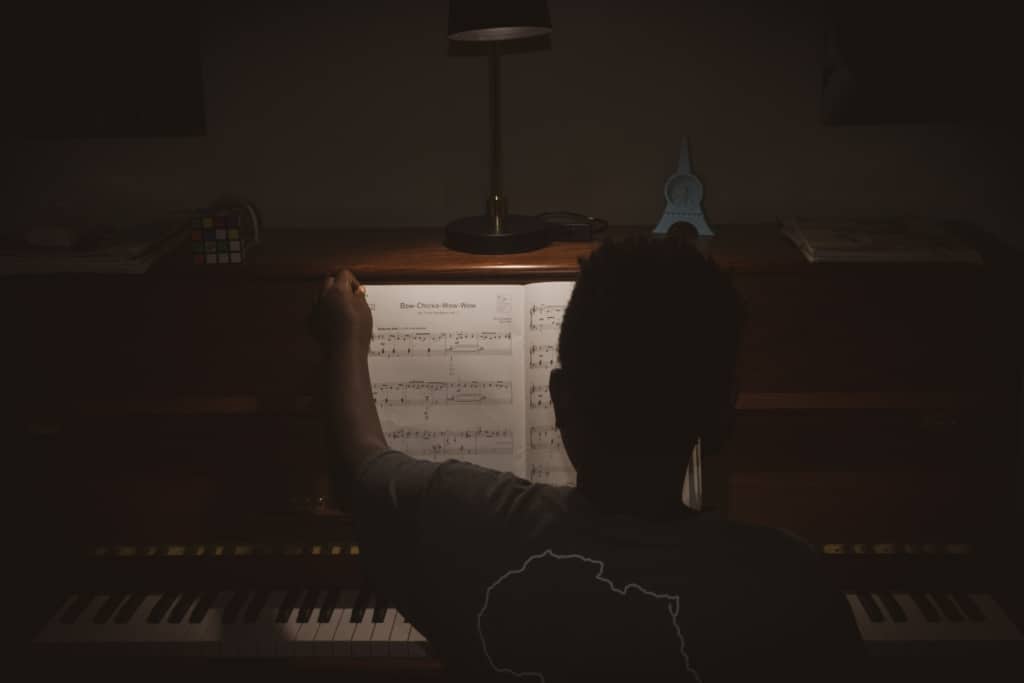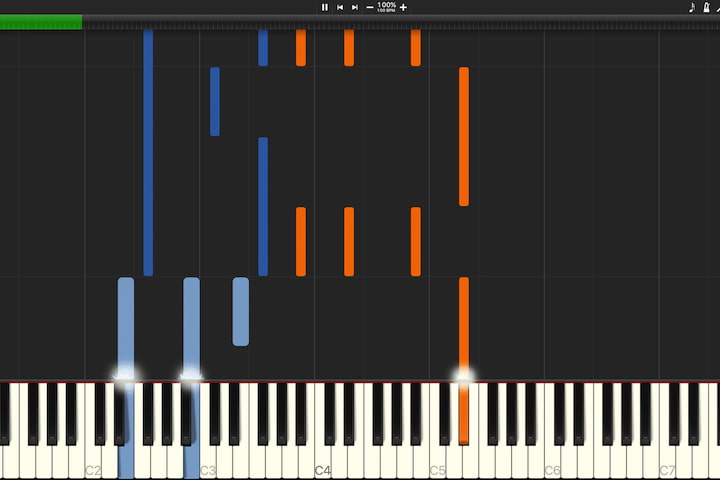
Discover My Sheet Music Arrangements on OKTAV
I recently started to share my sheet music arrangements on OKTAV. In this post, you learn a bit more about the platform.

If you are here, you are probably wondering how to learn piano. In this post, I provide suggestions on how it can be approached and provide links to useful learning sources.
Before you proceed, you need to think about the following questions. Do you want to learn piano by yourself? Do you want to learn it fast? Do you want to be a great pianist, or just able to play some simple songs? For many years, there have been great barriers to learn piano, because you would need an acoustic piano, be able to afford a teacher and so on. It’s not like that anymore. Today, digital pianos can be bought relatively cheap and there are plenty of online learning sources available at the fraction of the cost of teachers.
Hiring a teacher is most efficient to learn fast and correctly. However, if this is not an option for you, then it’s a great solution to start learning by yourself from online learning sources.
Generally, there are three aspects of learning piano:

I have decided to distinguish between three approaches to learning piano (not to be confused with the three aspects introduced above). You may think, that you have to choose a specific approach for you. That is not necessarily the case, because many learning sources (online or teachers) combine these approaches to make sure you learn everything. But it’s great to have an understanding of the different ways of learning.
In the classical approach, the focus is on your ability to read sheet music and your technique. Usually, there is less focus on music theory. This approach is great if you just want to focus on learning to play the piano (and ignore the theory) – you will primarily be able to play written music, such as Mozart, Beethoven, or contemporary music like Ludovico Einaudi or Yiruma, but you will not be able to sit down at the piano and improvise by ear. Read more about the approach here.
The contemporary approach has its foundation in music theory. It allows you to understand the piano from a theoretical point of view, and then play by ear. The contemporary approach is great if you want to play accompaniments to vocals, jazz, or awesome pop solos. Read more about the approach here.
In these modern days, it has also become popular to learn piano with the visual approach/app learning, i.e., using visual software that shows what to play, such as Synthesia or flowkey. People tend to choose this option because they are not able to read sheet music, and learning it seems like too big of a hurdle. If you just want to play some simple tunes, then the visual approach may be fine, but if you are more serious about what you want to accomplish, then learning sheet music will likely benefit you a lot in the long run. Read more about the approach here.
Learning to play piano this way may not be as fast and intuitive as the visual approach but down the line, it may make you a better pianist. The first two major milestones for you are to learn how to read simple sheet music and then learn some very simple melodies.
You want to adopt a proper technique from the very beginning so combining your practice on new melodies with some simple exercises is a good idea. Playing some simple scales (starting with C major) can be great for both your finger coordination but also hand separation (the ability to play with both hands). Follow the learning sources below to get started.
Learning sources
Peterson Piano Academy (online): Jason Peterson offers an online piano course which focuses on technique and sheet music from the very beginning. At his course, you start from scratch and learn everything you need to know (even some music theory). Check his course out here! (affiliate link).
Find a teacher: If you want to take the classical approach with a teacher, make sure you find someone with a classical background. It means, not a jazz pianist but instead someone who has played a lot of Mozart, Beethoven etc. He will also be able to teach music theory if it has your interest.
Free Online Sources
Learn sheet music:
Scales & Exercises:
Starting melodies:
Tips for beginners
Learning your very first melody can be frustrating. Your fingers may not want to do what your mind tells them to, and playing with both hands can seem completely impossible. It is very important that you start with something simple. Then practice right hand and left hand separately before you combine them. When you are ready to combine both hands, then start extremely slowly (one note at a time). Once it starts working for you at a very slow tempo, then you can slowly start to increase the pace. Patience is key to success here!

This approach is for those who want to become good at piano accompaniment for songs, playing solos, jazz, and so on. This mainly constitutes non-instrumental music which includes vocals. It means that all songs can generally be played in two ways – i.e., play the exact sheet music as with the classical approach or just play accompaniment using chords. When you play accompaniment you don’t use sheet music, but build your own arrangement instead. Thus, it does require some more experience before you will be able to do that so starting off with simple melodies and exercises is fundamental. As opposed to the classical approach, you want to start learning a lot of music theory early in the process. Among others you should focus on:
Practicing the bullets above will give a great understanding of the piano. You will understand how notes can be combined and you will not need written music to be able to play something. Furthermore, you will soon be able to play some simple chords while singing your favorite song (if that’s what you want). Follow the learning sources below to get started.
Learning sources
Peterson Piano Academy: Jason Peterson takes a broad approach and teaches you everything relevant – also for contemporary music. You’ll learn sheet music, chords, scales, etc. Check his course out here! (affiliate link).
Find a teacher: If you want to take the contemporary approach with a teacher, make sure you find someone with a contemporary background. That is, someone with a modern focus such as jazz, pop, etc.
Free Online Sources
Learn sheet music (recommended):
Music Theory:
Scales/exercises:
Starting melodies:
Tips for beginners
As a complete beginner, this approach may be difficult. You may be better off starting out with the classical (or visual) mindset, and once you feel you have adopted a reasonable technique you can start exploring the world of more advanced music theory. Practicing melodies extremely slowly is also important, as you may lose confidence if you keep trying to play in the original tempo before you are ready to do so!
If you want to learn a simple melody here and now, then the visual approach is great. Visual tools such as flowkey and Synthesia show you what to play, and then you simply try to follow along. When you have done that for a while you may actually be able to play some melodies on your own. Flowkey is an app made with a focus on giving you a smooth learning experience, and is something I can recommend if this approach appeals to you.
Only learning songs using visual tools, will not teach you sheet music or music theory. Some apps, also offer lessons on scales, chords etc., but it can be tempting to ignore these because you don’t learn any new songs to impress your friends. Just bear in mind, that it may be a great idea to learn some music theory!
Suggested apps

No matter which approach you choose, the technical aspect of playing is the same. If you start learning melodies with visual tools (apps), then you may develop bad technical habits, because you don’t have a teacher to correct you. A teacher is very helpful for things as correct finger placement, providing exercises to learn hand separation, and so on.
I believe the contemporary approach is difficult to learn by yourself – it requires a lot of theoretical knowledge. If this is the path you want to follow, my recommendation is to find a good piano teacher.
I want to thank you for reading so far and wish you good luck with your piano journey. Remember, no matter how you choose to approach it, I’m just happy you started! Feel free to leave a comment or send a mail with thoughts or feedback.

I recently started to share my sheet music arrangements on OKTAV. In this post, you learn a bit more about the platform.

Do you wonder whether you should go with sheet music or visualizers to learn new songs? Learn what I have to say on this topic.

Have you ever wanted to record your piano keyboard playing but didn’t know where to start? Or maybe you’ve tried recording with a microphone, but

Get a comprehensive look into the full process behind my videos. Both video and audio production is covered.

In this Q&A, I answer the most common questions I get across my platforms.

In this video, I invite you into my home studio. I show all the equipment I use, for you to get some inspiration for your